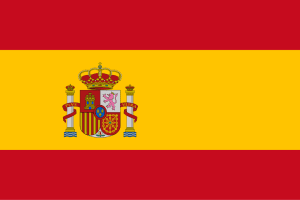
| Colors | HEX Code | RGB | CMYK |
|---|---|---|---|
| Red | #C60B1E | 198, 11, 30 | 0, 94, 85, 22 |
| Yellow | #FFC400 | 255, 196, 0 | 0, 23, 100, 0 |
The Spanish Flag is made of three horizontal stripes of red at the top and the bottom, and a yellow stripe in the middle. The yellow stripe is wider than the two red stripes which are equal in width. The coat of arms adorns the flag off-center, closer to the hoist.
Meaning of The Spanish Flag
The red and yellow colors represented the monarchy in Spain. The coat of arms currently adopted on the flag features the shields of old Spanish kingdoms, in addition to the pillars of Hercules, and a crown added on top to show respect for the role of monarchy in Spain.
History of the Spanish flag
The Bourbon Dynasty ruled Spain in the 17th and 18th centuries, and their flag had a white background with different versions of a coat of arms that featured the pillars of Hercules and a motto to signify the Spanish exploration expeditions. In 1875, King Carlos III decided that Spain needed a flag that should distinguish it from other nations. Examining different designs, he chose the non-proportional flag of red-yellow-red colors, and the coat of arms close to the hoist. The flag was introduced in 1875 and was used until 1939 when the Fascist General Franco ruled Spain, after the end of the Spanish Civil War that started in 1931. He replaced the coat of arms with a more elaborate one, including the eagle of St. John and the yoke and arrow symbols. It was modified twice during Franco’s rule. After the death of Franco in 1977, Spain moved to a democratic political system with King Juan Carlos. A new coat of arms was adopted. The current version of the Spanish flag was adopted in 1981.